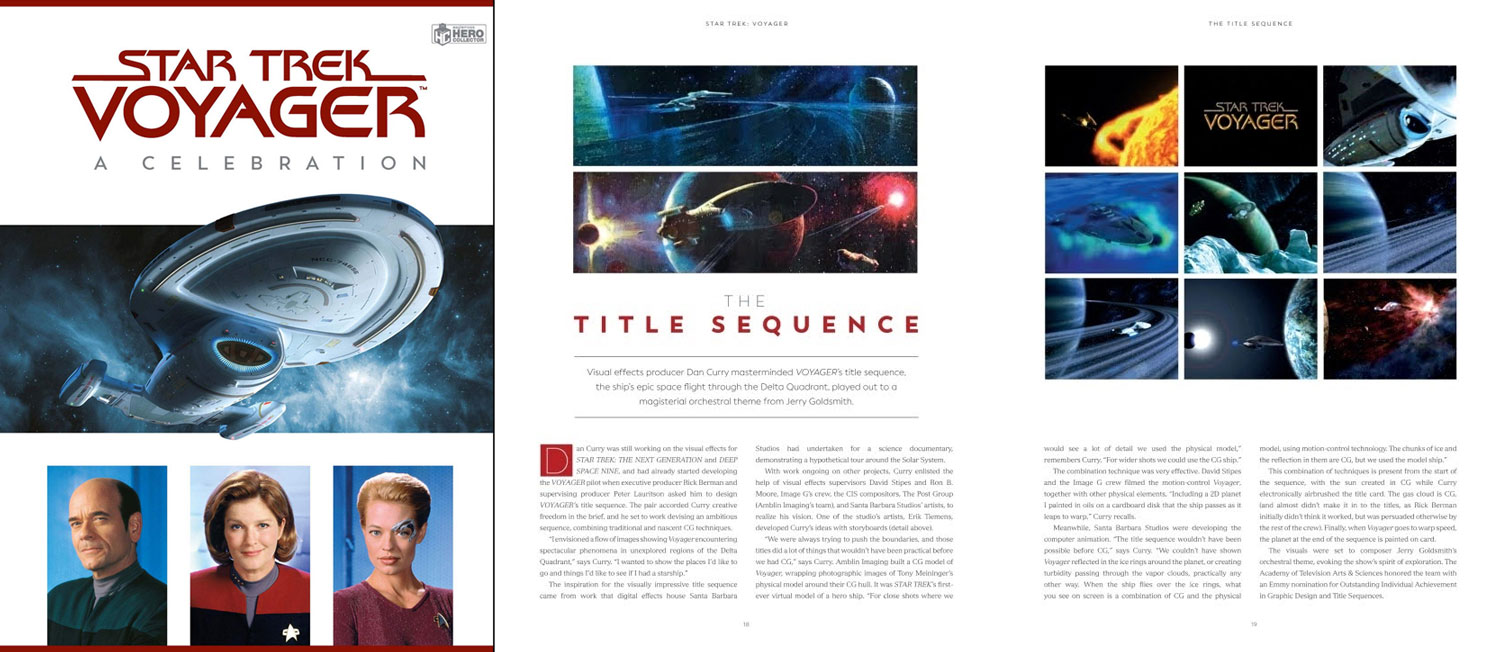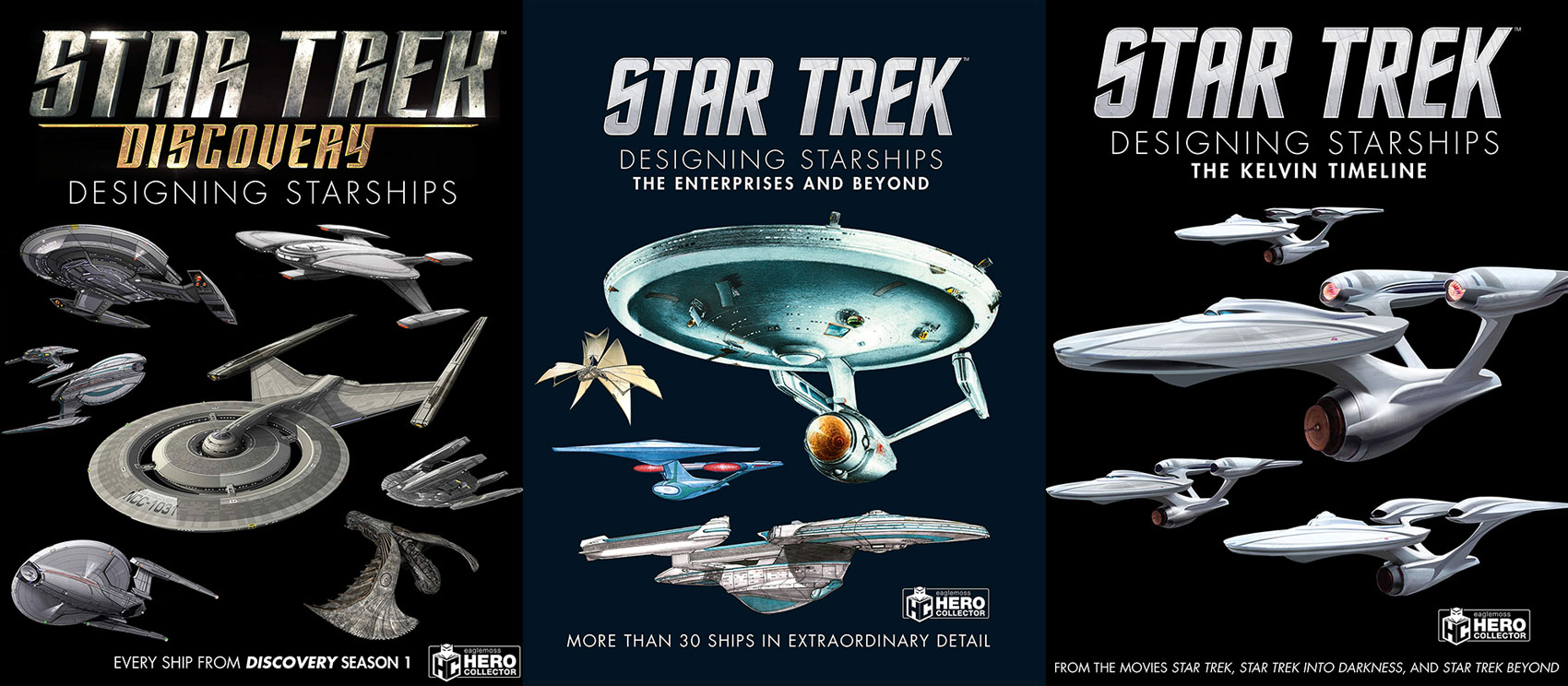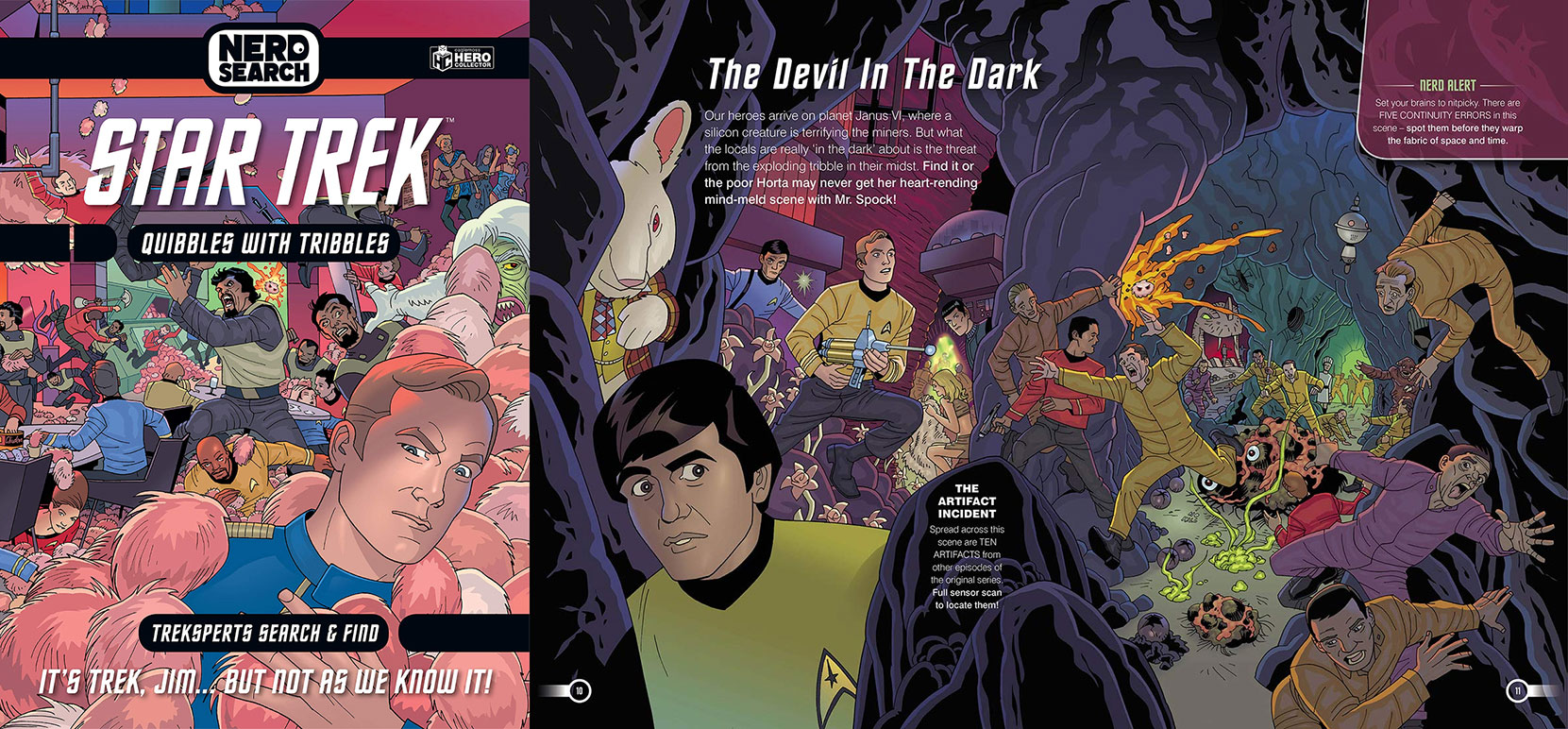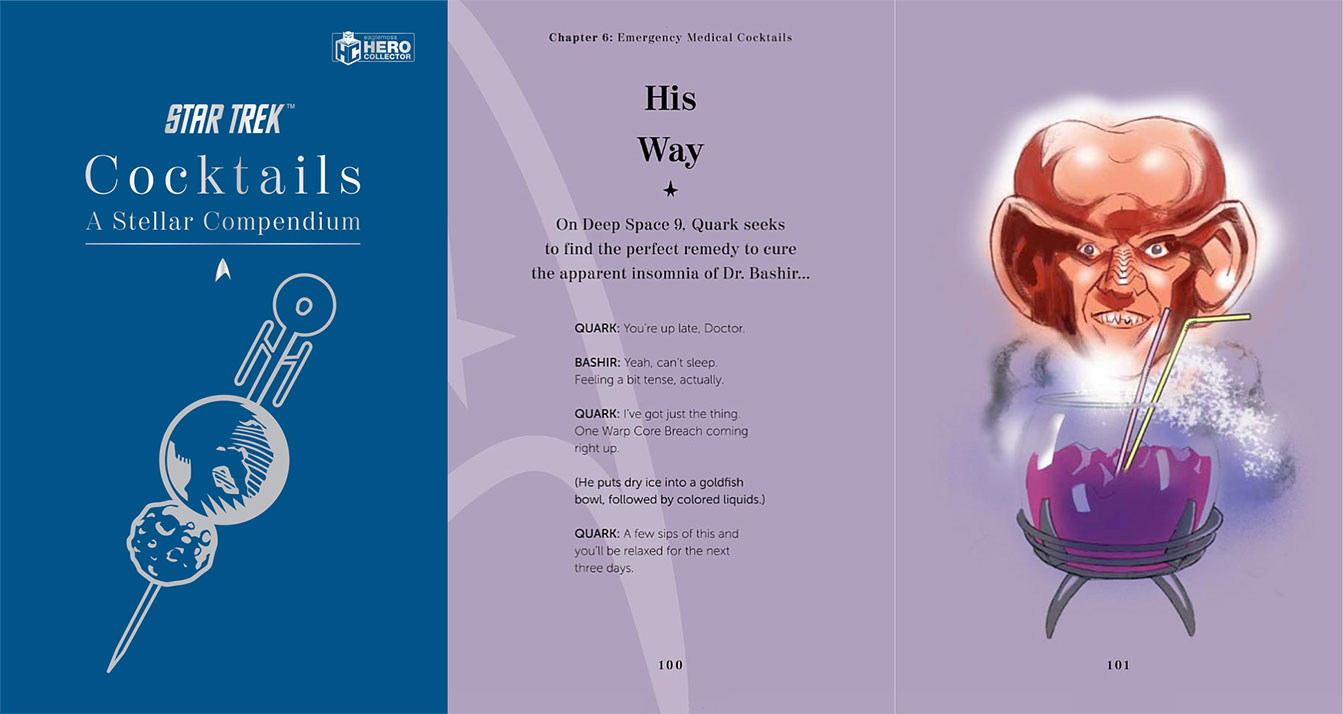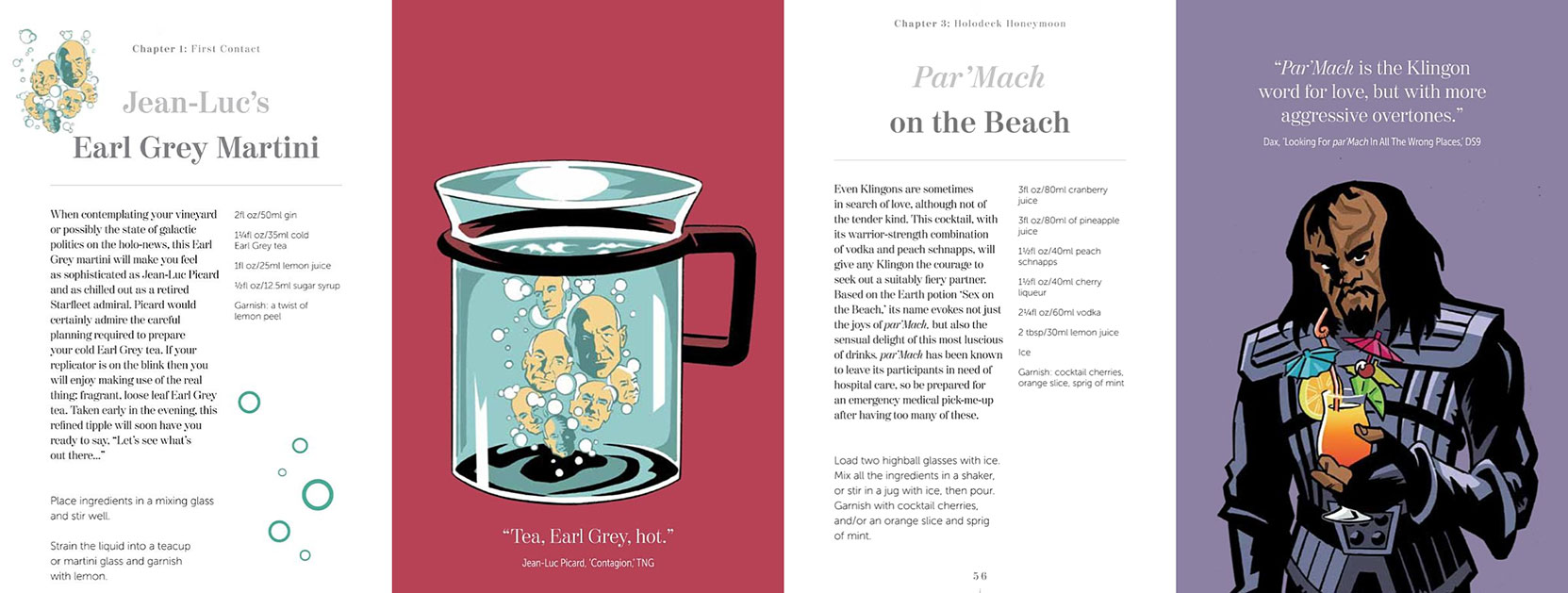Many Star Trek fans know Eaglemoss / Hero Collector as the home of the long-running Official Starships Collection model series, which has been bringing collectors dozens and dozens of miniature starships for the last several years.
Over the last year or two, the company has been branching out into the wider Star Trek universe, expanding their wares from model starships alone to books about the Trek starship fleets of Federation and alien races and beyond — now taking a spotlight look back at Star Trek: Voyager for the series’ 25th anniversary, and more.
To get our arms around all of the upcoming new publications from the Hero Collector team, our own Alex Perry sat down to chat with longtime head of licensed products — and author — Ben Robinson to get a look at what’s coming from the publisher in the next few months.
* * * *
 TREKCORE: In recent years, you’ve become known as the admiral of the fleet and public face of Hero Collector’s various Star Trek Starships collections. However, I know that your history with Star Trek books and publishing goes back quite a bit further than that.
TREKCORE: In recent years, you’ve become known as the admiral of the fleet and public face of Hero Collector’s various Star Trek Starships collections. However, I know that your history with Star Trek books and publishing goes back quite a bit further than that.
I think most people know you as the ‘ships guy,’ so tell me a little bit more about your history as ‘Ben Robinson, the books guy.’
BEN ROBINSON: I got a job in Star Trek because I worked in publishing and I knew about Star Trek, that’s how it came about. I was working at Dorling Kindersley on interactive CD-ROMs, which shows you how long ago it was. The internet had just been invented.
I come from, really, a publishing background I guess, and television and publishing are my past. I’ve always wanted to do books. It’s nice to be able to put stuff back in a book form.
We started out with Star Trek Fact Files, [which] was a printed publication. Then I ran the Star Trek Magazine in the US for four years and did countless interviews and got to know a lot of people doing that.
Publishing is really my beginning and may well be my end but, yes, I think of myself as the books guy who happens to do the ships and the figurines and all that kind of stuff.
TREKCORE: We’ve been seeing some of the material from the Star Trek Fact Files showing up again recently in some of the illustrated handbooks you’ve been doing for the Starships line like the Enterprise, Voyager and upcoming Deep Space 9 books.
ROBINSON: That’s right. We did Kirk’s Enterprise and Pike’s Enterprise as well actually. Then the Enterprise-D and then, earlier this year, we did Voyager and then, next year, we’ve got Deep Space 9 coming. The thing about the Fact Files, as you say, they’re massive and unwieldy and 18 binders long.
I always wanted to take the best material from the Fact Files of those incredible illustrations and put it out in book form. Those illustrated handbooks are really the most thorough attempt to document the ships as they appeared upon screen with illustrations of pretty much every room that you saw on the screen.
I think, when you see the density of illustration in them, it’s really nice to be able to present them in a more modern way as well. I’m very pleased to be able to bring that material out in a format that I think really lets it shine and puts it together as a nice book really.
TREKCORE: After several years of doing ships and the graphic novel line, now, there’s been this big push into doing more published books — the ship books, the encyclopedia books — and then some of these new releases that you have coming up.
It strikes me that it must be difficult, after 30-odd years of working on Star Trek publishing, to find new and interesting approaches to the franchise.
ROBINSON: No, it’s quite the reverse actually. I think, in 23 years, I’ve be constantly thinking of things that I would like to do and I think Star Trek‘s an incredibly rich and fertile thing. There are lots of things that you can do with it that haven’t been done.
I think we’re barely getting started at publishing. There are some things that are kind of obvious that I think we can do in a way that hasn’t been done before. The Shipyards books is a really good example. There’s a Star Trek Encyclopedia but, to make a Star Trek Encyclopedia of ships, which was kind of obvious, given what we’ve been doing for the last seven or eight years, is a different task.
The brilliant website, Ex Astris Scientia, does that but we can make beautiful reference books with CG renders of all the ships and we have got pretty much all the original CG files. For the Voyager ones, we’ve been going through and I’ve been finding ships that are like, “Oh, I didn’t realize that was in that episode. That’s in the background.”
Or “That’s what that looks like.” It was just a blur on the screen. That idea of doing a Jane’s Fighting Ships for Star Trek is something that — it seems kind of obvious once you do it and then you realize, “Well, actually, this is like a 10-volume thing.” I don’t know if it’s actually 10 volumes but it’s something like that.
TREKCORE: There are two Starfleet, one Federation, one Klingon and then we’ve got The Delta Quadrant coming up.
ROBINSON: Which is in two volumes. There are so many ships in Voyager. That’s when CG really kicks in so then there are a ton of those. Then I guess they’d be — I have to decide how we handle what you have after that because you have different eras.
You have, obviously, the Enterprise era, which there are a lot of ships. The TNG and DS9, basically, and the Original Series, of course, though there aren’t that many ships in that. Whether we do two, maybe even three, volumes of Alpha Quadrant ships as to — I was going to say ‘wrap the series up,’ but they keep making new ships. There are a lot of ships in things that people are going to see in the course of the next year.
We’ve just done this massive book, Star Trek Voyager: A Celebration, which I’m really proud of and really, really pleased with. The original pitch for it, it was like the best ever Star Trek convention in a book so everybody would be there. I think we did 30 interviews for it. It’s built around nine new interviews with the principal cast members and everybody talked to us and everybody was great.
It’s also built around a really substantial interview with Brannon [Braga], Jeri Taylor, and with Ken Biller. You get that sense of the whole story, which I think not many people have really taken that approach.
One of the things I’ve learned from all of these interviews that I’ve done over the years is that there are all these little bits that intersect. It takes a village to make an episode of television, and it’s nice to be able to put that together in a way that doesn’t just have one person’s part of the story.
It’s really interesting looking back at Voyager now, between 25 and 18 years after the fact, and you realize what a really good show it is. Everybody had, as Brannon was saying, at the time, people were giving it a hard time for not being TNG, but actually what was wrong with being TNG? Everybody loved TNG! It is really interesting to look back on something and realize it’s perhaps not exactly the way you remembered.
There are a lot of really nice behind-the-scenes stories in that book that I hadn’t heard. I always figure if I haven’t heard something, then it’s probably — lots of people haven’t heard of it.
TREKCORE: Could you tease something, like one of the behind the scenes revelations in the book?
ROBINSON: My favorite one, there’s just silly stories. I was talking to Bryan Fuller about taking pitches. He was saying that there was this guy who kept coming back and pitching stories in which Debbie Harry came to visit the crew of Voyager. It was always a beautiful alien played by Debbie Harry, because the guy was friends with Debbie Harry. It just made me laugh. There are lots of little stories like that.
It’s just got nice little stories of people talking about what it was like to work on the show. From the interviews, I got a really strong sense of what the cast are like and they’re all lovely, actually, they’re really nice people. Some of the nicest interviews I’ve ever done. That’s a really satisfying experience and I’m really pleased with this hefty book. It’s a proper book.
TREKCORE: That’s great for 25th anniversary of Star Trek Voyager! The Next Generation and Deep Space 9 got themselves substantial companion style books that had the behind the scenes details. Then the Voyager Companion was very underwhelming by comparison.
I personally am really excited to finally get a book that does justice to the show as a whole, by allowing the actors and creatives to speak a bit more about their philosophy and experiences while they were there.
ROBINSON: It’s the book that Voyager always deserved and has never had. I am really pleased that we’ve been able to deliver it. I really hope people enjoy it. I really enjoy writing it and I think it’s really interesting. I think there’s a lot in there, a lot in there. I think you’ll come away with a much stronger sense of who the actors are, who the writers are, and what it took to put the whole thing together and why it was the way it was, and in many cases, why it was as good as it was.
TREKCORE: You mentioned having talked to Bryan Fuller — Bryan’s not talked about much since his departure from Star Trek: Discovery, but in the various different Discovery pieces you’ve done, you’ve managed to pull out of him some different bits of information about his original vision for the show.
Do you ever dream about being able to work with him to tell the full story of what he wanted from the show?
ROBINSON: I think it’s a hidden gem, if you pick up our Designing Starships: Discovery book, what you were talking about is Bryan talks a lot in it about what he intended for the show originally, and why these ships are the way they are. I was talking to him about how everybody complained about the square nacelles, and he was like, “Oh, that was because Discovery was going to disguise itself as a Klingon D-7.” What? He’s like, “Yes, well, it was going to do this and that and the other.” That’s interesting!
I do know quite a lot more about what Bryan was planning for Discovery and it is a really interesting story. Bryan is an extremely nice man and very friendly and very helpful. He sent me all the rejected pitch documents for episodes of Voyager as well… none of which have actually made it into this book.
There’s a little bit about Kes; he was responsible for working out how Kes would leave. There’s like, “Oh, we could have done this. We could have done that, we could have done that.” There’s a wealth of stuff out there and Bryan’s footage has been helpful.
TREKCORE: Let’s talk Quibbles with Tribbles, which is just an incredible name and such a cool idea. A Where’s Waldo? for picky Star Trek fans. Where does an idea like that come from?
ROBINSON: An idea like that comes from my friend and colleague, [Hero Collector Head of Product Development] Stella Bradley. She said, “you love this thing. You’re big fans of it, and all you want to do is complain about what’s wrong with it.” To which we said, “Yes, that’s kind, that the point.”
She had this idea that we would do a search and find, that there would be deliberate mistakes in it. Glenn Dakin, who wrote it, is the main driving force behind it, but we would sit down and say, “Oh yes, we could put this in,” or, “We could put that in.”
We put a spread up on StarTrek.com — there are 22 hidden things in the picture. I think it took people nearly two days to find everything, which I was pleasantly surprised by.
TREKCORE: I consider myself to be pretty good. I think I only got to like 18, 19 on my first go around, it was the last couple that really confounded me.
ROBINSON: Good, that’s what I like to hear! I think it’s a really clever, really fun idea.
It leaves people really happy, I think, which is all you can ask for from anybody, is a bit of happiness. I hope everyone really enjoys it. I think it’s a bit of fun. It’s a perfect gift for anybody who has a Star Trek fan in their life. Of course, it’s incredibly competitive, which is the other thing that we all are.
TREKCORE: The book is also extremely up to date. The spread that was posted on StarTrek.com also had a little bit of Lower Decks content in it as well I noticed.
ROBINSON: It did! At the last minute. We were giving it StarTrek.com and went, “Oh, there’s nothing for Lower Decks on this one. We must put something from Lower Decks.” I can’t tell you what it is then I’d be giving it away.
That is a segue into another book because the Lower Decks element in that spread is remarkably like the cover to our Star Trek Cocktails book, which is another Glenn Dakin book.
TREKCORE: Just from watching the episodes, cocktails are not necessarily something you would think went together with Star Trek. But Star Trek The Experience had a number of beloved Star Trek-themed cocktails, and that tradition has carried on at Star Trek Las Vegas and other Star Trek conventions.
So what’s up with the Star Trek Cocktails book?
ROBINSON: Chris Thompson, who is our brand manager, actually suggested it. If you google ‘Star Trek cocktail,’ you get 4.5 million results. That shows you how many people like a Star Trek cocktail!
I think obviously, there’s Romulan Ale and all that kind of stuff but I think Star Trek fans like a party, and they’re a very sociable bunch of people.
TREKCORE: Despite popular myth.
ROBINSON: Absolutely. I have to say, Star Trek conventions are some of the most inviting and sociable places you could possibly ever be. Star Trek has a philosophy of infinite diversity and infinite combination and that means you can’t be nasty to anybody, basically.
I think on the whole, Star Trek fans are really nice people. I hope they all enjoy a cocktail as well. When this is over, we can all get together and share a cocktail rather than sitting at home and making them for ourselves.
TREKCORE: These are all 100% genuine Earth cocktails that you can make this at home?
ROBINSON: Yes, absolutely. No Tranya required. Basically, it’s a classic cocktail book with a real Star Trek twist. You’ve got Pike’s Mojave Mojito or Sisko Sazerac. That was basically my contribution was telling Glenn where people came from. It was like, “Oh, yes. McCoy, he likes mint juleps.” Then, of course, I forgot Finagle’s Folly.
It’s basically a really good cocktail book. It’s just that they all have a Star Trek twist to it. There’s Bashir’s London Fog. There are 40 recipes in here, including the Earl Grey Martini. They’re all very much real cocktails that you can really make and enjoy, I hope.
TREKCORE: You also have a new release coming out, that does feel very appropriately timed for the situation in which we find ourselves, and that’s Spock’s Little Book of Mindfulness, which I think we could all do with a little more of at the moment.
ROBINSON: Absolutely.
TREKCORE: Again, where does the inspiration for a book like that come from?
ROBINSON: That one I can take the credit/blame for, although again, this is another Glenn book.
Spock’s Little Book of Mindfulness actually came about by accident. We were talking about a book publishing program, which has been a big thing for us for the last couple of years. And someone said, “Have you got anything about mindfulness? Mindfulness is really big right now.”
He didn’t mean anything to do with Star Trek at all, he just meant have we got anything to do with mindfulness. I thought, “Oh, Star Trek mindfulness.” I thought, “Well, there’s nobody more mindful than Spock!”
Glenn and I sat down again and I was like, “I’ve got this idea that Spock would be this logical, sane calm person and how would he react to the world that we’re in.”
Just like, “What do you do if you’re Spock and you turn up in 2020?” You just raise an eyebrow and just go, “Really?” Glenn’s a brilliant cartoonist, as well. He used to have cartoons in national newspapers here in the UK. We did a bit of research together and we found all the bits of wisdom that Spock ever utters and then Glenn took them and worked out how you would apply them to real life, to your own life.
I think it’s everything I hoped it would be. It is very funny. It’s very clever. It’s also actually really rather wise. Again, I think it will make people smile, and it will make them into better people as well. That’s my hope. As I say, Glenn is absolutely the one who deserves all the credit for it. It’s a really timely book, as you say because since we had the idea the world has become a place in which you really need to be mindful.
The other thing we’re going to be doing because Glenn did these beautiful, New Yorker-style cartoons for the book is we’ll have a line of T-shirts and mugs coming that are this impassive Spock in the face of madness.
You were talking earlier about what else can you do with Star Trek. One of the things about it is that you can do something like this, which is just — it’s not “phasers on stun” and that kind of thing at all, but it’s still really Star Trek.
One of the things I love about this is that it turns out that Spock really is a classic cartoon character. He has all the attributes of a perfect cartoon character. He has this point of view. You just can confront him with insanity, which we are all confronted with all the time and he just– he looks impassive and raises an eyebrow.
TREKCORE: The perfect straight man.
ROBINSON: He is but it’s also kind of inherently funny. I think Leonard Nimoy would have liked it, I think it would have appealed to him.
TREKCORE: That’s a pretty packed publishing schedule before the end of this year and obviously some of the starship books are also scheduled to come out next year as well. Anything you can tell us about projects that are on the horizon?
ROBINSON: What am I allowed to tell you? [laughs]
I can tell you that you’re going to be very pleased and excited by the number of ships that there are in the next year, things that people haven’t seen yet, some of which will make people go, “Oh, wow” — and one thing in particular that will make people be like, “Ah, cool!”
The ships continue, even though the main collections ended, we will continue. There’s enough demand there that we’re going to go back and try and fill in some of the gaps of the things that, believe it or not, still got missed after 180 issues.
We got petitions. people were like, “No, I still didn’t get this one,” or “I didn’t get that one.” We’re going to go back and make a few more to fill in those gaps. Obviously, the first goal will be to do the really major gaps.
We did every Starfleet ship, every Klingon ship. Well… I say we did every Starfleet ship, but that’s not quite true. There’s a hint! We have now locked in plans every Starfleet ship, every canon Starfleet ship. There will be about four people who will know straight away which ones I’ve just announced.
There are things that I would love to do that we’re still trying to sort out the rights for. I would, in a heartbeat, do the Franz Joseph ships, and we are making some progress on that front.
I’m afraid it’s a bit of a ‘watch the space’ one, but do watch this space — we’ll get there. It feels like it’s all going in the right direction. It’s just there’s so much going on in the world of Star Trek that it’s not necessarily someone’s priority to go and sort this out. We have that.
We have stuff that you can imagine, I guess, which will be formally announced pretty soon. What can I say?
The regular collection may be coming to an end but we are far from finished with Star Trek ships! What was everyone most unexpected pleasure in the series? https://t.co/SqmAx4yPSS
— Ben Robinson (@BenCSRobinson) July 23, 2020
TREKCORE: For both books and for ships, how has the COVID-19 pandemic impacted the things you guys have been doing?
ROBINSON: I’ve worked even harder, only because it’s quite difficult for me to tell the difference between work and pleasure. When there’s nothing else that I can do I have a tendency to think, “Oh, I’ll just file these pictures,” or, “I’ll just talk to this person,” or whatever.
I think the Voyager book, actually, was a massive beneficiary of lockdown because everybody was stuck at home. When you’re like, “Hey, Robbie McNeill, are you free to talk?” and of course he was!
Normally what happens when you do interviews with people, very understandably, you get to the end of your half-hour, 45 minutes and they’re like, “I’ve got to go. This was great but I’ve got to go.” This time they were like, “Have you got any other questions?” I talked to Brannon, we had a marathon interview session, I think it was four and a half hours long.
Going over Voyager stuff and we both had a great time. It was a really fun conversation. Brannon’s so busy, that that would have been really tough otherwise, Roxann Dawson as well. Roxann and Robbie, both are very successful TV directors who are working all the time.
TREKCORE: What else can we talk about before closing out this marathon interview of our own today?
ROBINSON:. I think that these new books, I hope, show a slightly different side to what it means to be a Star Trek fan. Spock’s Little Book of Mindfulness, I think is a book that anybody with a sense of humor could pick up and read and enjoy. If you’re a Star Trek fan, you’ll get all the references and you’ll know, “Yes, he did actually say that in that episode.” If you aren’t, you will still think, “That’s insightful,” or “funny,” or both.
The cocktails book, again, it’s just like Glenn and Paul and Stella, who worked on that book it’s just, they’ve all got impeccable taste, and they’ve made a really beautiful book. Again, it’s very witty.
I always worry with Star Trek that we get a bit isolated as a community. There’s this very sort of a specific idea of what being a Star Trek fan is, and means. I don’t necessarily mean that as the critical — the media just assuming that we’re all in costumes all the time and all of that. I mean that there’s a certain kind of fandom, that sometimes seems like it’s the only kind of fandom… and there’s nothing wrong with it, but I’m really keen to show that there’s more.
Going back to your original question of what is there left to do after 30 years, there’s a lot to do and there’s a lot of fun to have, and there’s a lot of very satisfying explanation to do, as well. Stephen Whitfield’s The Making of Star Trek is a classic book, it really is. It’s not just because it’s about Star Trek, it’s because it’s about TV. It’s about how you make a TV show.
Oh and we’ve already got all the CG assets.
— Ben Robinson (@BenCSRobinson) November 1, 2020
I think the Voyager book, will give people an insight into how you actually make a modern TV show. There’s great bits and when people talk about the interaction between the writers and the actors. Now, Jeri Taylor was saying, “You’ve got to understand, when you create a show, particularly at that time, you were just creating potential. You were throwing out things that might work, or might not work,” or whatever.
Then the actors come in, and she said about Kate Mulgrew: “Kate didn’t change how we saw Janeway, she just fulfilled her in ways that we could never have anticipated.” It’s that kind of interplay between the writers seeing what the actors are doing. Brannon said, how difficult it was to write for characters before they’d been cast. He said, “You found yourself as a writer doing Kate Mulgrew impressions as you’re writing the script.”
I think the book really does give you that insight and it’s a great big book about Voyager which is something the show has really deserved. I think that’s it, it’s not the same old same old. There’s plenty of new and interesting stuff to do and new and interesting ways in which to do it. I’m really, really pleased with what we’ve done.
I hope it’s just the beginning.



